On September 23, 2019, the 3rd General Meeting of the Gut Flora Transplantation Clinical Research Society “A Letter to Humanity from Gut Bacteria” was held.
In this issue, we report on the presentation by Makoto Shimizu, a senior researcher at the Institute.
You can watch the video below.
He took the stage with an entrance video.

Shimizu, director of the Symbiosis Institute, introduces
the hidden potential of intestinal bacteria.
The Job of Clinical Laboratory Technician and the World of Microorganisms
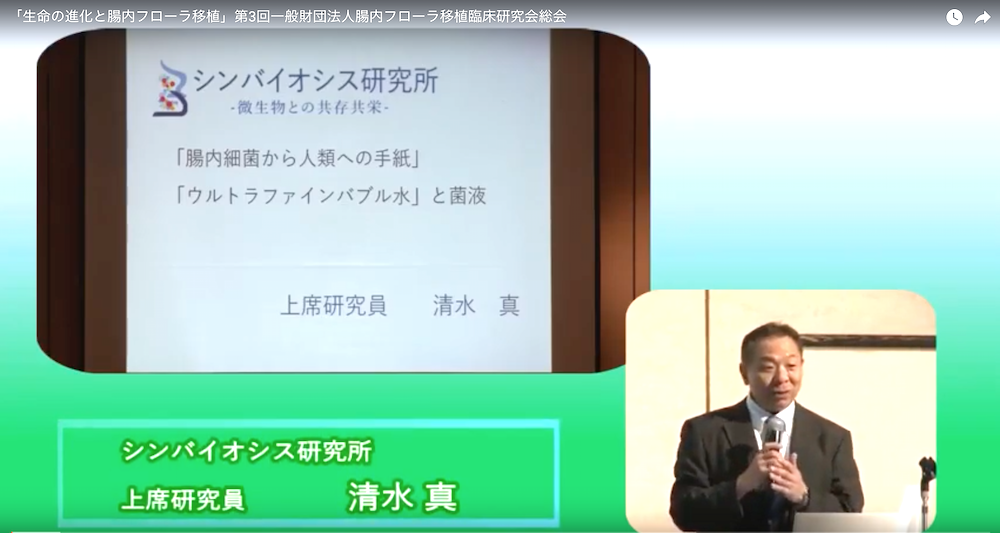
We clinical technologists believe that we are manufacturing engineers.
What part of manufacturing is that? You may ask.
Our main business is to accurately measure blood, pee, and stool samples requested by doctors.
For example, dissolve a tablespoon of sugar in a 25-meter pool, stir it, and measure the concentration on the other side. We are in such a world.
We also develop new items, research day and night whether we can return measurement results more accurately and quickly, and repeat experiments and verifications. This is the job of a clinical laboratory technician.
Our basic philosophy is that “the world will eventually evaluate us on its own,” to borrow a phrase from “downtown rocket.
I love “Shitamachi Rocket” and I also like the other saying “We are Imperial Heavy Industries”. The microbial world is similar to heavy industry in my opinion.
Microorganisms break down glucose to produce acids and gases. Each of these energies may not be significant, but when there are 1,000 trillion indigenous bacteria in the body as a whole, it becomes a tremendous amount of energy.
I believe that this is equivalent to heavy industry, such as rockets.
Thirty years ago, there was an NHK program titled “The Amazing Microcosm of the Human Body.
I was very surprised to see that the number of human cells, which until then had been said to be 70 trillion, was corrected to 37 trillion after the discovery of the DNA double helix structure in 1953.
To use an analogy to describe the amazingness of the human body, it would take seven Koshien Stadiums to artificially achieve a metabolism that would convert one glass of shochu water into vinegar and expel it from the body.
If the human body is a microcosm, then microorganisms can be described as the stardust scattered around it. Therefore, we have named our plan to explore the world of microorganisms the “Stardust Project.
As you may have guessed, it is a pastiche of “Shitamachi Rocket.
As a map of gut bacteria. A Letter to Mankind from the Gut Bacteria Speaks

Here I will talk about the book Letters to Humanity from Gut Bacteria.
In fact, we thought that existing intestinal flora tests were difficult to understand the state of one’s stool. Therefore, we, Symbiosis, wanted to be of help to teachers and patients, so we profiled it focusing on its clinical significance.
Our testing is currently outsourced to Technosuruga Labs, and thanks to them, we are able to perform NGS (Next Generation Sequencing) testing with good accuracy under certain conditions. We also have one NGS machine in our lab, but it is only experimental at the moment.
A patent is currently pending for profiling.
We have created an easy-to-understand colored bar chart specifically for clinical significance. In addition to genetic classification, we also classify bacteria according to the metabolites they release, since they have many useful metabolites. We calculate our own evaluation axis of bacterial potency based on the balance of these factors.
Evolution of Life and Overhead Science

To put it simply, overarching science means integrating various fields of expertise, experimenting, and verifying.
Now, let me talk about evolution here. Originally, I believe that the essence of evolution is gigantism.
Now, let me talk about evolution here. Originally, I believe that the essence of evolution is gigantism.
Prokaryotes, the first life forms to appear on Earth, were about one micron in size.
Then, 2.9 billion years ago, eukaryotes appeared. Their size was about 1 millimeter. In two dimensions, they were 1,000 times larger, or one million times larger in volume.
Furthermore, when they acquired lungs and went up on land, plants and animals emerged one after another. They are another 1,000 times larger and another million times larger in volume.
In other words, life eventually became a trillion times larger.
Furthermore, when they acquired lungs and went up on land, plants and animals emerged one after another. They are another 1,000 times larger and another million times larger in volume.
On the other hand, the theoretical value is that in normal evolution, it should take 15 billion years to reach human form. But in reality, it took about 4.6 billion years to become human. Where does this gap come from?
In fact, the history of mutations explains this.
For example, there have been several times when galaxies collided and radiation rained down and wiped out most of life on Earth. Then there have also been a couple of global freezes. It is safe to say that the Earth has been a dead planet.
Organisms that survive the harsh environment undergo a specialized evolution. This is how we became accelerated, as a mutation.
In the process of evolution, we became huge by incorporating mitochondria and other organs into our membranes. This is because the Earth at that time had a very high concentration of oxygen and it was necessary to protect the nucleus from oxygen, which is extremely poisonous. This is how eukaryotes are formed.
The normal way of differentiation is stem evolution, in which one life form divides into two, but in periods of accelerated differentiation, it is called coronal evolution, in which one thing divides into many at once.
I would like to ask for your cooperation here.

Those who do not like snakes, please raise your hands.
Thank you.
So about a third of you like it (laughs).
In fact, when our ancestors first came on land, they were about the size of rats. At that time, snakes were natural enemies.
That genetic information is definitely recorded in your genes, and this is the interesting part of evolution.
So what happens to those who did not raise their hands? That’s mutation (laughter).
Prokaryotes have a simple form with genetic information encapsulated in a membrane. We eukaryotes, on the other hand, have a complex structure that incorporates many things.
Human cells as eukaryotes and bacterial cells as prokaryotes. The symbiosis of human and intestinal bacteria can be considered a super life form.
Is there an optimal solution for intestinal flora transplantation?
Let me be serious for a moment.
Symbiosis does research on a daily basis based on a variety of assumptions.
I don’t want there to be any confusion in what I am about to tell you, so I would like to explain what is academically evidenced with a shrimp symbol and what is our tentative theory with a crab symbol.
donor selection
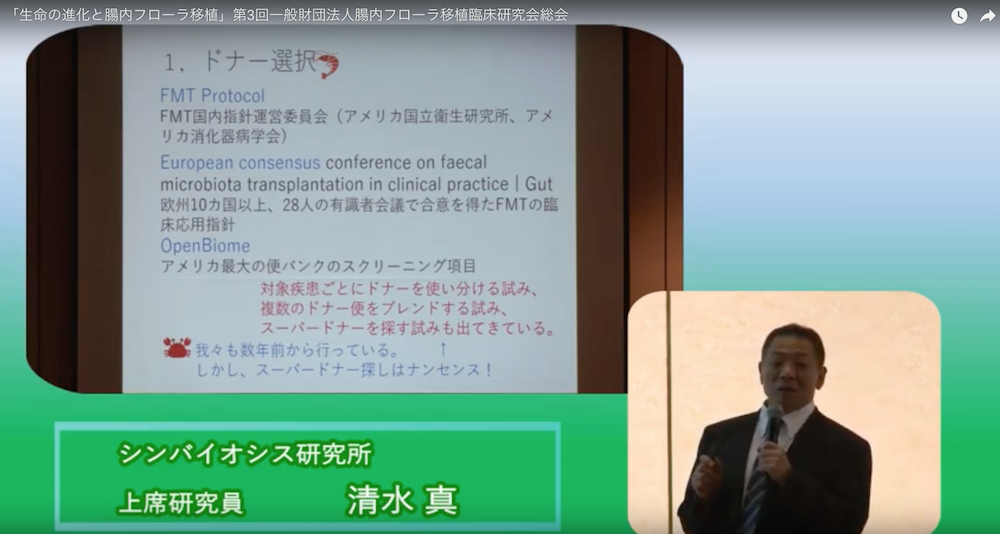
What kind of donor is used for transplantation may be your biggest concern.
In fact, there are already various protocols in Europe and the United States.
In recent years, the search for super donors and the blending of multiple donor stools is finally being experimented with, but our study group has already been doing this for several years.
Number and frequency of transplants
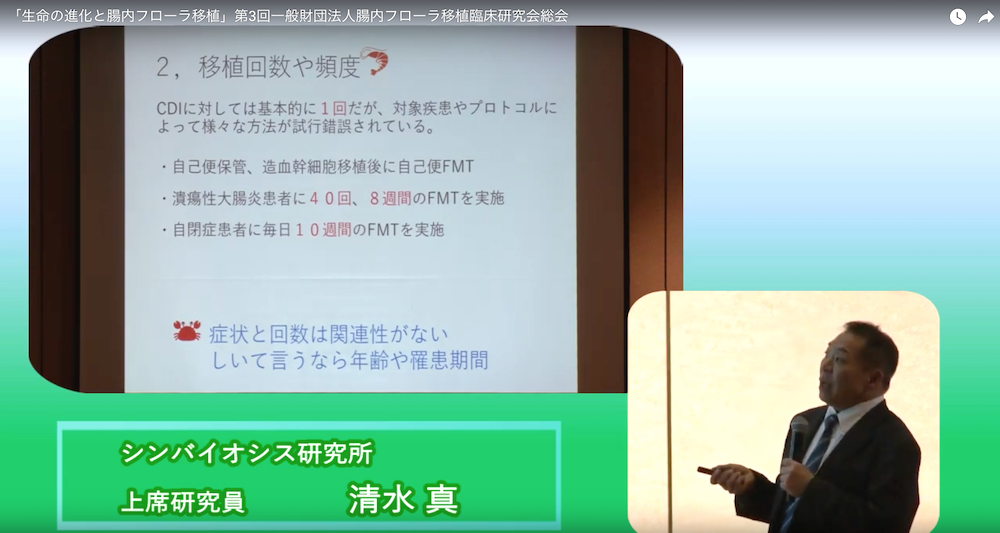
IN CDI, THE CLINICAL TRIAL IS BASICALLY CONDUCTED AT ONE TIME, BUT PROTOCOLS HAVE BEEN CHANGED FOR OTHER DISEASES SUCH AS ULCERATIVE COLITIS AND AUTISM.
We believe that frequency may not be related to symptoms/disease. Rather, we believe that age and years of disease may be the key.
Specifically, we feel that frequency increases from 17 to 8 years of age, when the thymus gland of the immune school finishes its work.
Does it need to be treated in an anaerobic environment?
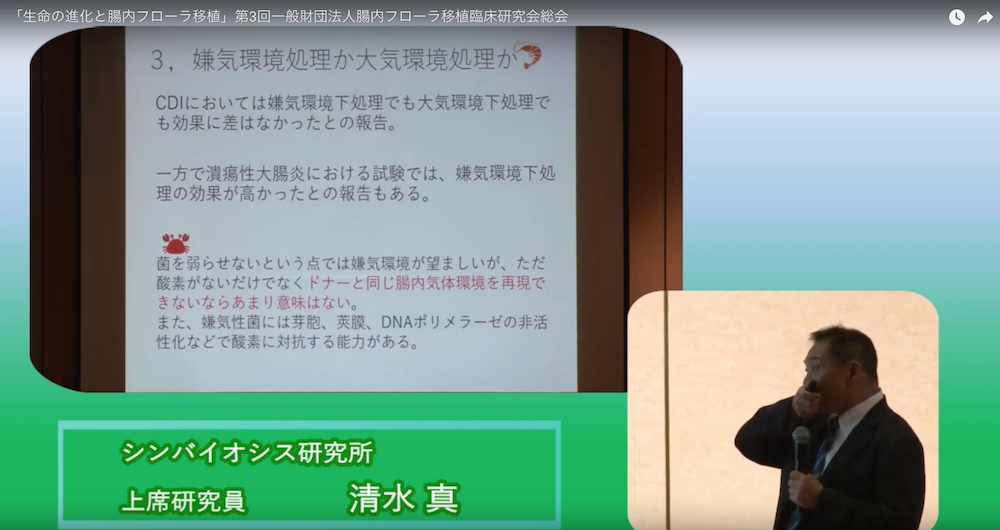
There is a common belief that anaerobic bacteria die when exposed to air, but this is a big misconception. They know how to protect themselves by covering themselves with spores and capsules.
Reference URL: Do bacteria living in the intestines (anaerobes) die when exposed to air?
Use fresh or frozen mail.
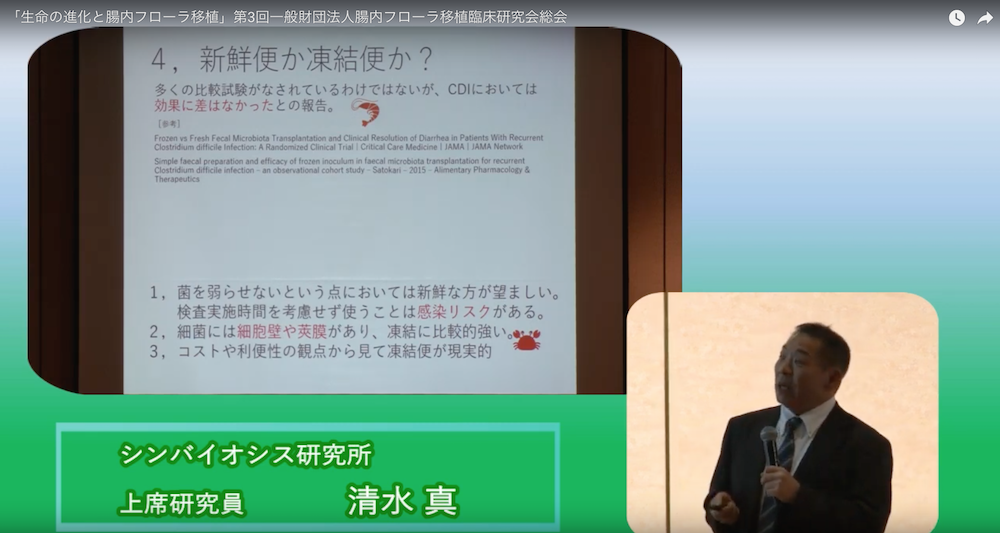
When clinical trials first began, the standard in Japan was to use fresh stool and the donor was a safe person within the second degree of kinship.
If fresh stool is used, it takes two days to test the donor stool for susceptibility (presence of resistant bacteria). Other blood and urine tests would take four days.
We aim for the highest level of safety in the world, so we use stools that have been cryopreserved at -80°C.
target disease
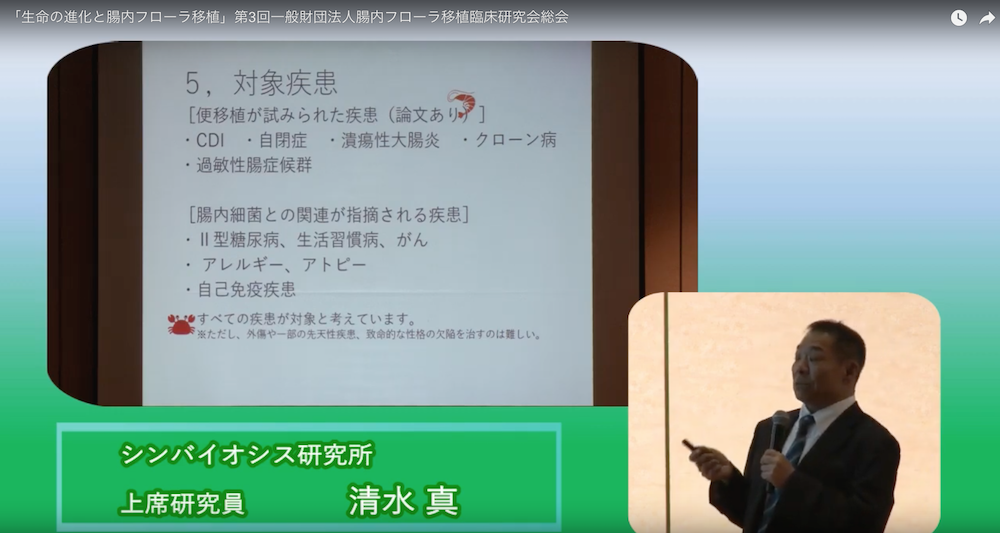
There are many diseases that have evidence as intestinal flora transplants, only to be associated with intestinal bacteria.
However, I believe I can be of some help, with the exception of some diseases such as trauma.
Concentration of transplanted bacteria solution
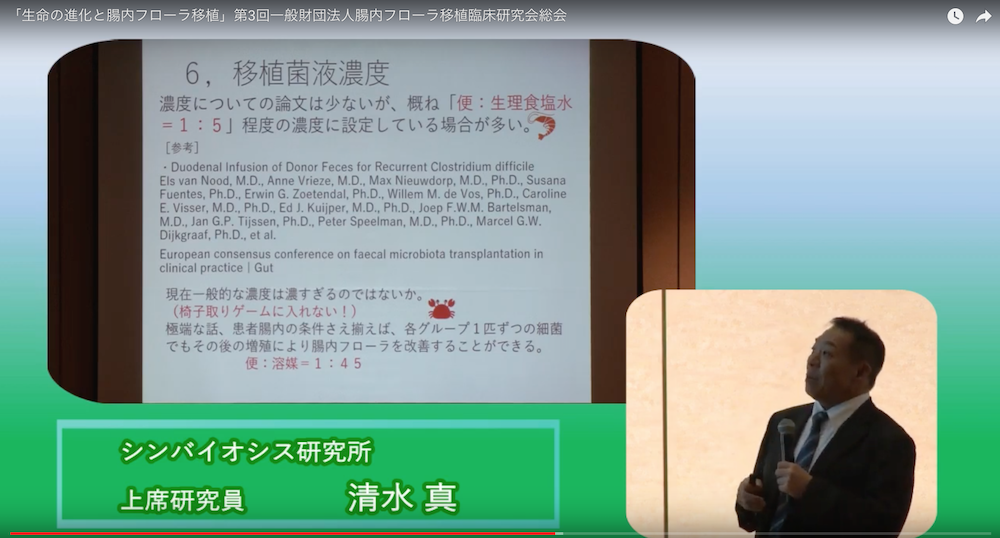
The most common concentration of fungal solution that appears in papers worldwide is about 1:5.
Some statements can be found that the thicker the better.
But we think this concentration is too high.
Let us compare the bacteria that live in the intestines to a game of musical chairs.
Suppose there are only five chairs to sit on, because the intestines are inevitably covered with organic dirt. Suppose there are 10 bacteria that you would like to see take up residence there.
If there are not enough chairs, they will sit in order of strength, and if the concentration is unnecessarily high, it can lead to an imbalance.
So, I think a thinner concentration is better. In our case, we adjust the concentration to about 1:45.
In addition, with our solvent, ultrafine bubble water, we are also trying to physically increase the “chair” by using its surfactant action.
Use of Metabolites
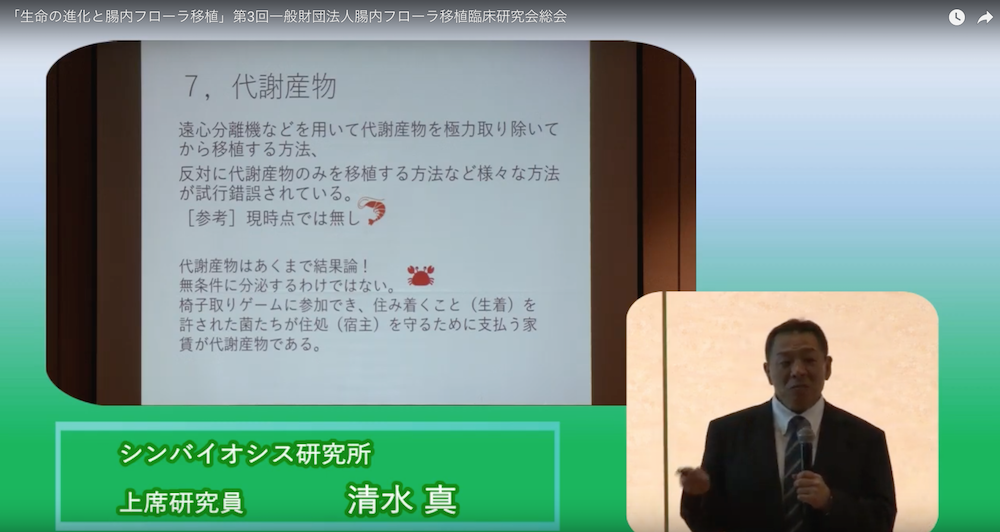
Some people believe that it would be a good idea to centrifuge the bacterial fluid and transfer only the metabolites.
In this regard, we believe that metabolites are only a consequence. Rather, the balance of metabolite-producing microorganisms is more important.
Metabolites are like rent paid by the bacteria living in the intestine to us, the host, and we cannot receive rent when there is no resident.
Dosing Method
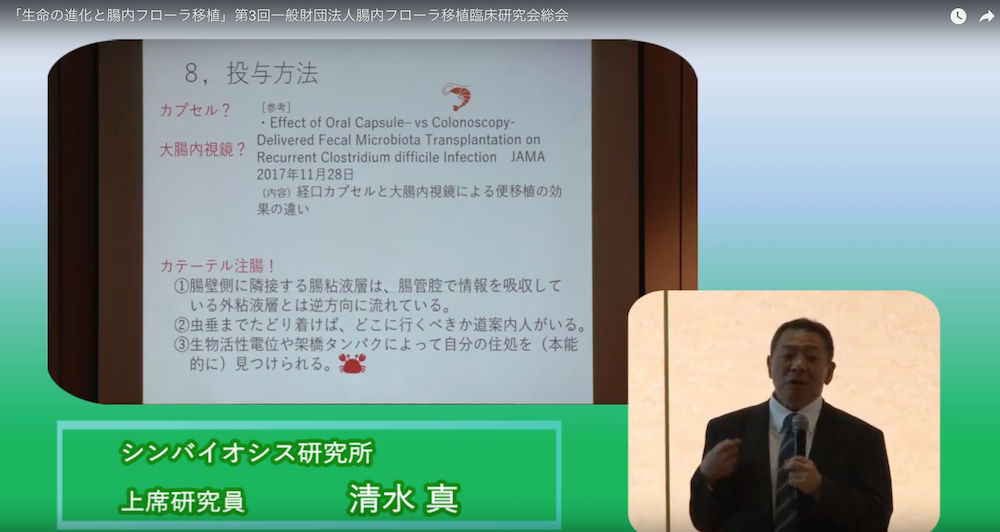
Oral capsules and endoscopes are becoming mainstream in protocols around the world.
However, we do not employ either because of the physical and emotional pain involved.
We use soft rubber catheters for implantation.
Now we are trying to get them to grow on their own on the fungal fluid.
1,The intestinal mucus layer adjacent to the intestinal wall side flows in the opposite direction to the outer mucus layer, which absorbs information in the intestinal lumen.
2,If you make it to the appendix, you have a guide to where to go.
3,You can find your home by bioactive potentials and cross-linking proteins.
(extra) Antibiotics and bowel cleansing
One of the protocols for clinical trials is to use antibiotics to first strike the bacteria.
While I think it is important to have evidence that the treatment worked or did not work, it is heartbreaking for us to see the loss of diversity in patients who have not responded to the treatment.
As for the method of cleaning the intestines again, I think it is good because the current method does not change the balance of bacteria.
Bacterial solution using nanobubble water (ultra fine bubble water)

I will now tell you about our approach.
Earlier in the section on concentration, I mentioned that we make our bacteria solution at a ratio of 1:45.
We have our own plant and make ultrafine bubble water exclusively for our research group.
It is only a theoretical value, but it is made based on a calculation of 950 million fine bubbles in 1 cc. With current science and technology, the only way to measure the particle size distribution is to dilute it, but measurements at Beckman Coulter show that the bubbles are more than twice as large as those made by other companies.
We believe that the use of this ultrafine bubble water will help deliver bacteria to the intestinal mucus layer and improve the preservation accuracy of the bacterial solution.
In addition, our intestines have a redox potential of minus 200 mv, and by achieving a value close to this value, we make it easier to acclimate.

When large bubbles such as champagne or carbonated water are reduced to 1/1000th of their original size, they become micro-nano bubbles (fine bubbles). Microbubbles slowly rise to the surface in water and disappear.
Ultrafine bubbles are one thousandth further in size and are widely used in industry.
Ultrafine bubble water is characterized by the fact that its surroundings are covered with negative electrons.
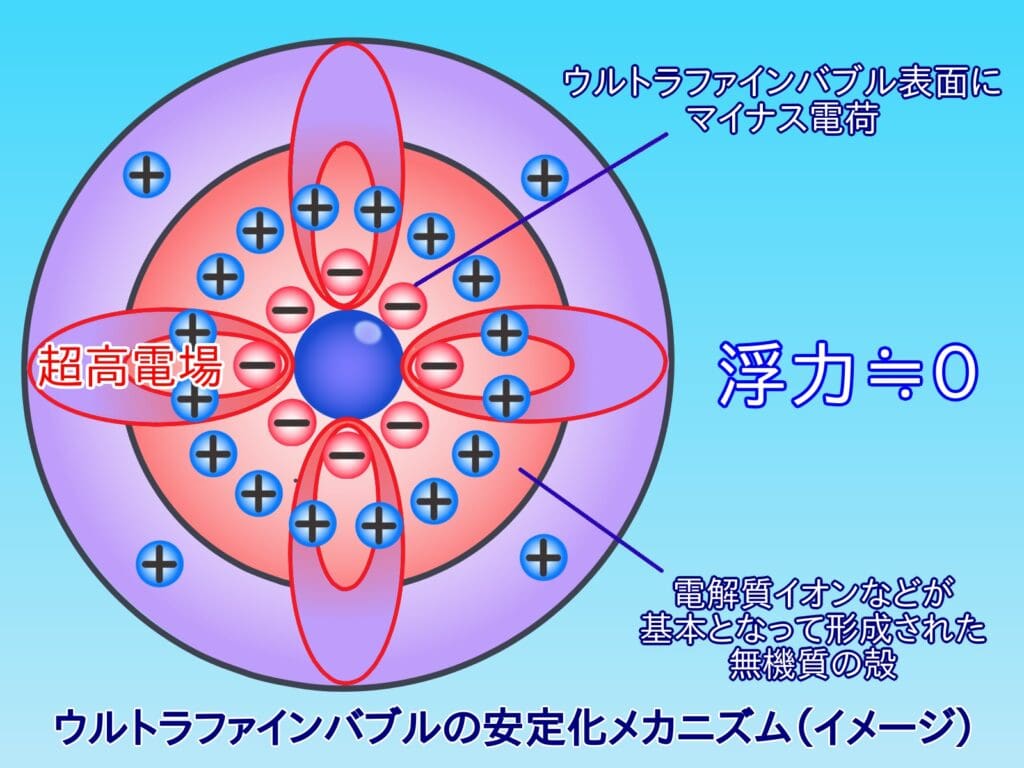
Organic dirt is positively charged, so fine bubble water can adhere to it and lift it out. This leads to the chair game I mentioned earlier, but our Ultra Fine Bubble is much finer and can get between the dirt and the intestinal wall due to its surfactant effect.
This is why we believe that we can physically increase the number of places for bacteria to live.
We make our water by a method called rotational shear method. According to our theory, when bubbles are made by rotation, they should be torn off and become smaller and smaller due to the difference in centrifugal force.
Back to the bacteria.
In our bacterial solution, ultrafine bubbles are suspended in the solution as if attracted by the attraction of the negatively charged bacteria.
This is just an image, and the bubbles are not covered with the bacteria in this way, but rather, the bubbles form a wall that is attached to the bacteria but not separated from them.

This is intended to avoid interfering with the function of flagella and cilia. Cilia are very important because microorganisms use cilia to exchange genetic information instantaneously.
By treating stools with this Ultra Fine Bubble water, we expect to
-Easier biosorption (cross-linking effect, draws in, increases chairs)
-Minimizes contact between bacteria and prolongs the life of the bacterial solution
-Controlled redox potential
My dream is a working donor bank!
I actually have a dream of having a mobile donor bank.
This is because it is important to use analyzers in the same environment, and accuracy can vary depending on the environment.
Various analyzers are mobile and loaded in a car to measure immediately where the donor or patient is.
We envision liquefied nitrogen for stool preservation. The current temperature is -80°C, but we believe that a temperature of about liquefied nitrogen would be ideal for more complete stool preservation.
Incidentally, mobile medical vehicles are common in Europe and the United States and are still in operation.
WE HAVE LOADED OUR VEHICLES WITH MRI AND ULTRA FINE BUBBLE WATER PLANTS AND HAVE COLLABORATED WITH WAKAYAMA MEDICAL UNIVERSITY AND THE UNIVERSITY OF TOKYO.
This is a mobile ultrafine bubble water plant we own, and after 4 hours with the truck wings closed, it is class 5 clean.

Although there are still many issues to be resolved, we always try to conduct basic research to help patients and doctors in the clinical field.
Thank you for your attention.

















